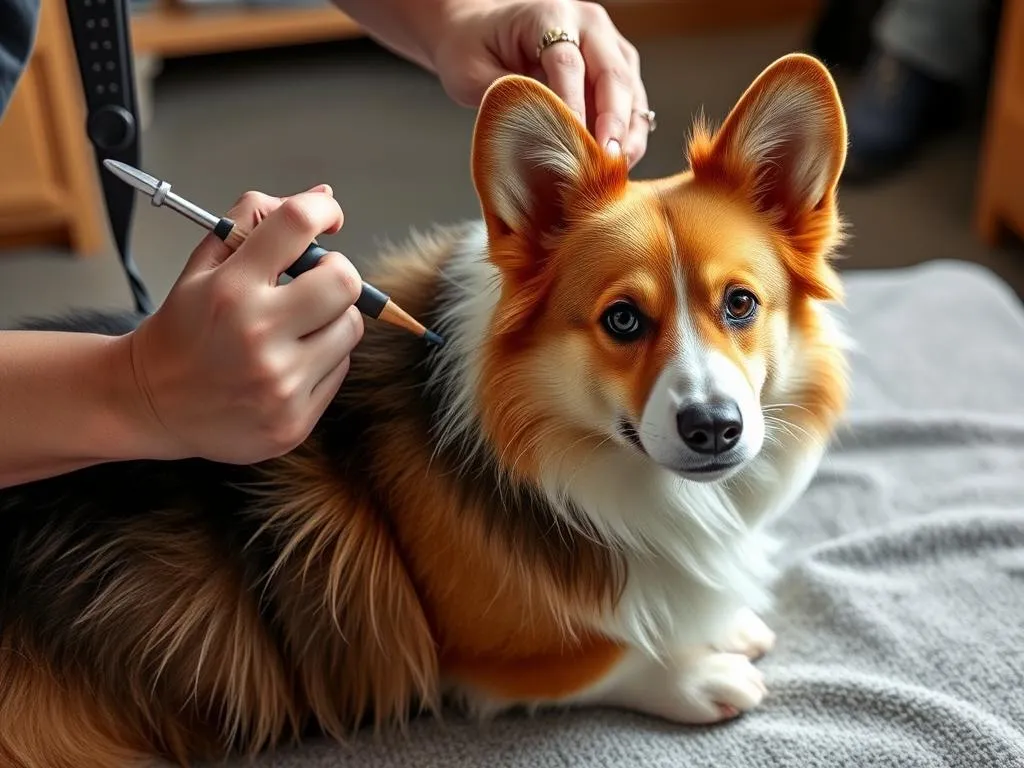
Introduction
Grooming is an essential aspect of dog health care that is often overlooked. Proper grooming not only keeps your Corgi looking its best but also contributes significantly to its overall health. For Corgis, grooming is particularly important due to their unique coat type and physical characteristics. In this guide, we will explore how to groom a Corgi, covering essential tools, techniques, and a grooming schedule tailored for this delightful breed.
Understanding Corgi Characteristics
Breed Overview
Corgis, originally bred as herding dogs, are known for their short legs and long bodies, which gives them a distinctive appearance. There are two main breeds: the Pembroke Welsh Corgi and the Cardigan Welsh Corgi. Both breeds share common traits, including a sturdy build, a vibrant personality, and a strong work ethic. Typically, Corgis weigh between 25 to 30 pounds and stand about 10 to 12 inches tall. They possess a double coat, which is thick and fluffy, making them prone to shedding, especially during seasonal changes.
When it comes to temperament, Corgis are known for being intelligent, playful, and affectionate. They are social animals that thrive on interaction with their families, making them wonderful companions.
Unique Grooming Needs
Corgis have a double coat consisting of a soft undercoat and a longer topcoat. This unique coat structure requires regular grooming to prevent matting and tangling. Additionally, Corgis can be susceptible to certain health issues related to their coat, including skin conditions and ear infections. Regular grooming helps maintain their coat’s health and prevents these potential problems.
The Importance of Grooming for Corgis
Health Benefits
Grooming is not just about aesthetics; it plays a crucial role in your Corgi’s health. Regular grooming helps maintain skin health by removing dirt, debris, and dead hair that can accumulate in the coat. This process allows for better airflow to the skin, reducing the risk of skin irritations and infections.
Moreover, grooming prevents matting and tangles, which can lead to discomfort and skin issues. By keeping your Corgi’s coat well-maintained, you also promote healthier ears and teeth. Grooming offers an opportunity to inspect your Corgi’s ears for any signs of infection and check their teeth and gums for overall dental health.
Behavioral Benefits
Grooming is an excellent way to build trust and strengthen the bond between you and your Corgi. Regular grooming sessions can create a positive experience for both you and your pet, making them more comfortable with the process over time. This trust can help reduce anxiety during grooming and other veterinary visits, ultimately leading to a happier and more relaxed dog.
Essential Grooming Tools for Corgis
Brushes and Combs
To effectively groom a Corgi, you’ll need the right tools. Here are some recommended types of brushes:
- Slicker Brush: Ideal for removing loose hair and preventing matting.
- Undercoat Rake: Perfect for reaching the undercoat and removing dead hair.
When selecting brushes, consider brands known for their quality and durability, such as Hertzko and FURminator.
Bathing Supplies
Bathing your Corgi is an essential part of their grooming routine. Here are the key supplies you’ll need:
- Dog Shampoo: Choose a hypoallergenic or moisturizing formula to protect your Corgi’s skin.
- Non-Slip Mat: This helps your Corgi feel secure while bathing.
- Towels: Keep several on hand for drying after the bath.
Nail Care and Ear Cleaning Tools
Corgi grooming also includes nail trimming and ear cleaning. Here are the essentials:
- Nail Clippers: Opt for a guillotine-style clipper or electric grinder for safe trimming.
- Ear Cleaning Solution: Use a vet-recommended solution along with cotton balls for gentle cleaning.
Step-by-Step Guide on How to Groom a Corgi
Preparing for Grooming
Creating a calm environment is crucial for a successful grooming session. Choose a quiet space where your Corgi feels comfortable. Gather all necessary tools before starting to ensure a smooth process.
Brushing Techniques
Regular brushing is essential for Corgis, ideally done at least once a week. During shedding seasons, consider brushing them every few days. Here are some techniques:
- Brushing the Undercoat: Use the undercoat rake to gently pull through the undercoat, removing loose fur.
- Brushing the Topcoat: Follow up with a slicker brush to smooth the topcoat.
- Dealing with Tangles: If you encounter mats, use your fingers to gently separate the fur before brushing.
Bathing Your Corgi
Corgis typically require a bath every 4 to 6 weeks, depending on their activity level and environment. Here’s a step-by-step bathing process:
- Wet the Coat: Use lukewarm water to thoroughly wet your Corgi’s coat.
- Apply Shampoo: Lather a small amount of dog shampoo, ensuring you cover the entire body but avoid the eyes and ears.
- Rinse: Rinse thoroughly to remove all shampoo residue.
- Drying: Gently towel dry your Corgi. You can also use a hair dryer on a low setting, keeping it at a distance to avoid overheating.
Nail Trimming and Ear Cleaning
Trimming your Corgi’s nails should be done every 3 to 4 weeks. Here’s how to do it safely:
- Select the Right Tool: Choose either clippers or a grinder.
- Position the Paw: Hold your Corgi’s paw firmly while exposing the nail.
- Trim Carefully: Cut just above the quick (the pink part). If you’re unsure, trim a small amount at a time.
For ear cleaning:
- Inspect Ears: Look for dirt or wax buildup.
- Apply Solution: Use a few drops of ear cleaning solution.
- Wipe with Cotton: Gently clean the ear canal with a cotton ball, being careful not to insert it too deeply.
Grooming Schedule for Corgis
Frequency of Grooming Tasks
Creating a grooming schedule can help maintain your Corgi’s health and appearance. Here’s a suggested frequency:
- Daily: Quick brushing during shedding seasons.
- Weekly: Thorough brushing.
- Monthly: Bathing and nail trimming.
- Quarterly: Professional grooming if desired.
Signs Your Corgi Needs Grooming
Watch for these indicators that it might be time for a grooming session:
- Matting or Tangling: Visible mats in the coat.
- Behavioral Signs: Increased scratching or discomfort may suggest grooming is needed.
Common Grooming Challenges and Solutions
Dealing with Shedding
Shedding can be a challenge for Corgi owners, especially during seasonal changes. Here are some effective strategies:
- Regular Brushing: Consistent brushing helps minimize shed fur around the house.
- Diet Considerations: Ensure your Corgi is on a balanced diet to promote a healthy coat.
Handling Grooming Anxiety
Recognizing signs of anxiety in your Corgi is vital for a successful grooming experience. Look for:
- Whining or Barking: Signs of discomfort during grooming.
- Restlessness: Corgis may fidget or try to escape.
To alleviate anxiety:
- Positive Reinforcement: Reward your Corgi with treats and praise during grooming.
- Short Sessions: Keep grooming sessions brief and gradually increase their length as your Corgi becomes more comfortable.
Professional Grooming vs. DIY Grooming
When to Seek Professional Help
While many grooming tasks can be done at home, certain situations may warrant professional assistance. Consider seeking professional grooming if:
- Your Corgi has severe matting.
- You are unsure about nail trimming or ear cleaning.
- Your Corgi is anxious and requires specialized handling.
DIY Grooming Tips
Grooming at home can be cost-effective and rewarding. Here are some tips to help you succeed:
- Educate Yourself: Use online resources and videos to learn proper techniques.
- Practice Patience: Take your time and be gentle to build trust with your Corgi.
Conclusion
Maintaining a regular grooming routine is essential for your Corgi’s health and happiness. By understanding their unique grooming needs and following a structured grooming schedule, you can ensure your Corgi stays healthy and looks its best. Remember, grooming is not just a chore; it’s an opportunity to bond with your furry friend and keep them comfortable in their skin.
FAQs
How often should I groom my Corgi?
Regular grooming is recommended at least once a week, with increased frequency during shedding seasons.
Can I groom my Corgi myself?
Yes, many grooming tasks can be performed at home with the right tools and techniques.
What should I do if my Corgi hates grooming?
Start slowly, use positive reinforcement, and consider short grooming sessions to help your Corgi become more comfortable.
Is there a special diet to promote healthy skin and coat?
A balanced diet rich in Omega fatty acids can significantly improve skin and coat health. Consult your veterinarian for specific dietary recommendations.









